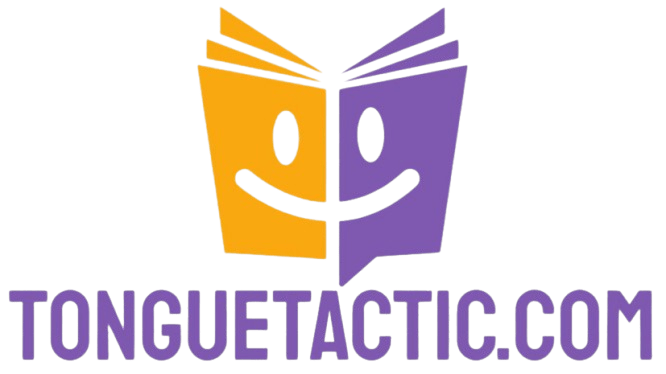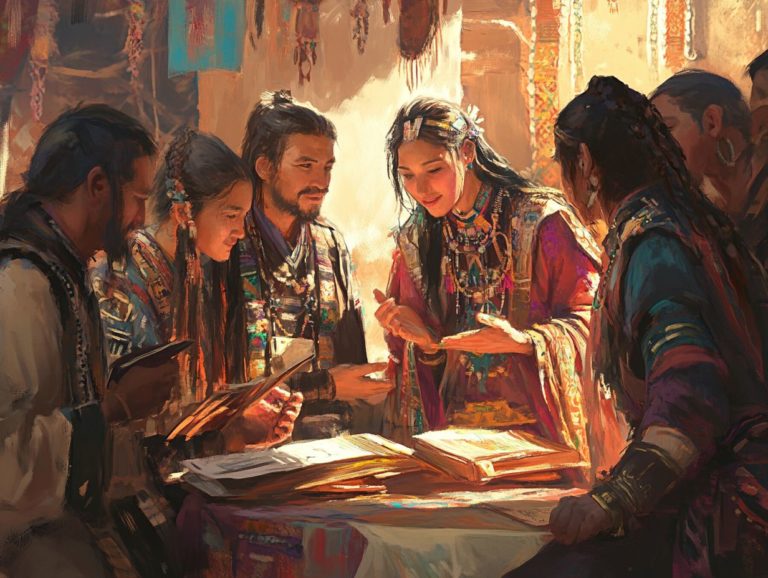5 ways movies enhance language and cultural understanding
Movies transcend mere entertainment; they are a potent vehicle for language acquisition and cultural immersion.
By exposing you to a variety of languages and showcasing vibrant traditions, films significantly enrich your language-learning experience.
This article delves into five essential ways movies can elevate your grasp of both language and culture.
It also offers practical strategies for integrating films into your lessons, highlights noteworthy examples, and addresses potential challenges you may encounter.
Dive into this exploration now to uncover how cinema can revolutionize your language journey!
Contents
- Key Takeaways:
- 1. Provides Exposure to Different Languages
- 2. Showcases Different Cultures and Traditions
- 3. Helps Develop Listening and Comprehension Skills
- 4. Increases Vocabulary and Grammar Knowledge
- 5. Encourages Cultural Empathy and Understanding
- How Can Movies Be Used as a Language Learning Tool?
- What Are Some Examples of Movies That Have Enhanced Language and Cultural Understanding?
- How Can Movies Be Used to Teach Cultural Differences and Similarities?
- What Are the Benefits of Using Movies in Language Learning?
- How Can Teachers Incorporate Movies into Their Language Lessons?
- What Are Some Potential Challenges of Using Movies in Language Learning?
- Frequently Asked Questions
Key Takeaways:

- Movies expose us to different languages, helping us learn new words and phrases.
- They showcase various cultures, enhancing our understanding and appreciation of diverse perspectives.
- Watching movies improves our listening skills through authentic dialogue.
1. Provides Exposure to Different Languages
Movies are a great way to expose you to different languages. They elevate your language-learning experience through engaging stories and captivating visuals that create a dynamic educational context.
By incorporating films from various cultures, you can learn new vocabulary and improve your listening skills while gaining insights into the cultural context that shapes the language itself.
This method helps you remember the language better and appreciate different perspectives.
The rich tapestry of visual narratives allows you to connect words and phrases with imagery, reinforcing comprehension even without verbal cues.
Listening to native speakers in authentic dialogues sharpens your pronunciation and auditory skills, making the learning process enjoyable and effective.
To enhance your exposure, educators can introduce interactive tools like subtitles, language apps, and discussion forums centered around movie themes.
Engaging in classroom activities such as role-playing scenes or crafting film reviews encourages active participation, allowing you to practice conversational skills while exploring the cultural nuances presented in films. This ultimately cultivates a well-rounded learning experience.
2. Showcases Different Cultures and Traditions
Movies serve as a remarkable gateway to diverse cultures and traditions, providing you with a rich narrative experience that profoundly enhances your cultural awareness and can help you discover ways to connect language learning with local culture.
By dissecting complex interpersonal dynamics and societal issues, these films immerse you in the cultural dialogues that shape language use.
Take “Zootopia,” for example; it explores themes of prejudice and acceptance through its vibrant animal characters, creating an ideal platform for discussions about stereotypes and their real-world implications.
Likewise, “To Kill a Mockingbird” dives deep into moral courage and social justice, allowing you to connect with historical contexts while refining your linguistic skills.
By harnessing these cinematic narratives, educators can inspire you to adopt effective communication methods and cultivate cultural empathy, ultimately nurturing a more inclusive learning environment.
3. Helps Develop Listening and Comprehension Skills
Utilizing movies in your classroom can significantly enhance your students’ listening and comprehension skills. They engage with authentic dialogues and varied accents, elevating their language practice to new heights.
Films create a context-rich environment where learners can cultivate analytical thinking and sharpen their comprehension abilities, enabling them to interpret and respond to spoken language with greater ease.
This immersive experience also serves as a valuable resource for tailored comprehension exercises that cater to different learning levels.
By incorporating targeted activities like dialogue analysis, scene reenactments, and context-based discussions, you can craft interactive lessons that not only make language learning enjoyable but also deepen your students’ understanding of how language operates in various social situations.
Recognizing cultural nuances, tone variations, and contextual meanings within dialogues allows learners to appreciate the richness of the language.
You can facilitate group discussions centered around cinematic themes, prompting critical thinking while addressing language subtleties, ultimately equipping your students with the skills they need to navigate real-world conversations with confidence.
Start incorporating films into your study routine today, and watch your language skills soar!
4. Increases Vocabulary and Grammar Knowledge

Movies can dramatically boost your vocabulary and grammar skills. By watching educational films like *Wonder* and *Romeo and Juliet*, you dive into rich language usage in a lively context.
This immersive experience also helps you build a strong vocabulary while sharpening your comprehension skills. You are exposed to informal language and complex grammar found in authentic movie scripts.
When you watch films, you see and hear how words fit into everyday conversations. This deepens your understanding of context and usage.
Teachers can harness this potential by integrating vocabulary exercises focused on key dialogues or phrases from the films.
Interactive tools, such as online quizzes and vocabulary flashcards derived from movie scripts, can engage you actively.
Group discussions and role-plays based on film scenes encourage you to use new vocabulary and grammar forms in a fun setting, reinforcing your language skills.
5. Encourages Cultural Empathy and Understanding
Engaging with films allows you to cultivate cultural empathy and understanding. You immerse yourself in diverse narratives that challenge your perspectives and improve your communication skills.
By exploring the complexities of various characters and their journeys, educators can design activities that encourage you to analyze motivations and conflicts in these stories.
Participating in a discussion circle after watching a film gives you a platform to express your views, ask questions, and share experiences, sharpening your critical thinking skills.
Role-playing scenes lets you step into different characters’ shoes, fostering a deeper emotional connection to various cultures. Through these exchanges, you learn to articulate your thoughts and embrace multiple viewpoints, enriching your understanding of the world.
How Can Movies Be Used as a Language Learning Tool?
Unlock the power of movies to transform your language learning journey. When you use innovative teaching strategies, films become a valuable tool in your learning arsenal.
By integrating films into your curriculum, educators can create immersive experiences that cater to different learning styles. This approach provides opportunities for interactive classroom activities that enhance your language skills.
This method encourages effective communication and fosters a collaborative environment among learners like yourself.
Imagine your teacher assigning a movie analysis project where you and your classmates dissect key scenes to explore themes, dialogue, and cultural nuances. These exercises sharpen your critical thinking while enriching your vocabulary.
Comprehension activities can involve watching selected clips followed by discussions or quizzes to check your understanding. Such methods encourage active participation, allowing you to practice speaking and listening in a lively context.
By creating these engaging opportunities, you’re more likely to connect emotionally with the material. This can lead to greater motivation and improved language skills.
Start watching a film today and watch your language skills soar!
What Are Some Examples of Movies That Have Enhanced Language and Cultural Understanding?
Movies like *Zootopia*, *Wonder*, and *To Kill a Mockingbird* elevate language learning. They offer rich narratives that encourage exploration of complex themes and diverse languages.
Take *Zootopia*, for example. It dives into themes of stereotypes and social justice. This film gives you a platform to discuss real-world societal issues while practicing vocabulary related to politics and ethics.
Then there’s *Wonder*, which emphasizes the importance of kindness and acceptance. It sparks conversations about empathy and inclusion essential ingredients for developing emotional intelligence in young minds.
Lastly, *To Kill a Mockingbird* prompts you to grapple with moral dilemmas and confront racial prejudices. This film serves as a valuable spark for discussions about historical contexts.
These films don t just entertain; they pull you into the world of language and culture, profoundly enriching your learning experience.
How Can Movies Be Used to Teach Cultural Differences and Similarities?

Movies serve as exceptional resources for exploring cultural differences and similarities. They offer nuanced portrayals of various societies and their unique practices.
By selecting the right films, you can create immersive learning experiences. These experiences encourage students to compare and contrast cultural elements, enriching their understanding of global diversity.
As students analyze the dialogue, visual storytelling, and character interactions, they gain valuable insights into a culture’s overt practices and underlying values.
Engaging students through group discussions about pivotal scenes can spark critical thinking. Role-playing activities to act out cultural scenarios foster empathy for others experiences.
Creative projects like film critiques can elevate the analysis. This approach allows learners to articulate their observations and reflections in a meaningful way.
What Are the Benefits of Using Movies in Language Learning?
The benefits of using movies in your language learning journey are numerous. They range from enhanced vocabulary acquisition and listening skills to a deeper cultural understanding and refined communication abilities.
By incorporating educational films into your curriculum, you engage in immersive experiences. These experiences capture your attention and ignite a genuine passion for practicing the language.
These visual narratives breathe life into the language. You hear authentic pronunciation and intonation while picking up colloquial expressions and slang.
For instance, watching a film like *Am lie* does more than introduce you to French culture. It encourages the integration of rich vocabulary and idiomatic phrases within context.
Educational films also expose you to various dialects, as seen in *The Intouchables*. This broadens your auditory range and comprehension skills.
By analyzing character interactions in these films, you sharpen your communication skills. This ultimately paves the way for greater fluency and confidence in real-life conversations.
How Can Teachers Incorporate Movies into Their Language Lessons?
You can effectively use movies in your language lessons by applying new teaching ideas that blend cinematic appeal with your educational goals. By thoughtfully adding films to your curriculum, you create engaging lessons that enhance your students’ language skills and nurture a love for storytelling.
To achieve this, start by selecting films that align with your learning objectives, considering themes, language complexity, and cultural relevance. Once you’ve chosen a suitable film, develop activities such as:
- Character analysis discussions
- Vocabulary-building exercises based on film dialogue
- Creative projects where students script their own movie scenes
For assessments, consider reflective essays or group presentations that allow students to express their understanding while reinforcing key language concepts. By curating content and pairing it with interactive activities, you help your students appreciate the art of film while effectively enhancing their language skills.
What Are Some Potential Challenges of Using Movies in Language Learning?
While movies offer great benefits for language learning, challenges may arise that you, as an educator, need to consider. Issues related to comprehension support helping students understand what they see and hear and content suitability can significantly impact how effectively films enhance the learning experience.
Recognizing these potential obstacles is crucial to ensure that films enrich the language journey without causing confusion or distraction. You may often find yourself navigating the differing language proficiency levels among your students, which can make it challenging for everyone to engage with the film together.
Cultural sensitivity is another challenge; diverse backgrounds might lead to misunderstandings of themes or humor in the film.
To tackle these challenges, try using subtitles in the target language to make understanding easier and more fun! Choose films that highlight universal themes for broader relatability. Engaging your students in pre-viewing discussions can also prepare them for cultural nuances, ensuring that the viewing experience is enjoyable and educational, ultimately fostering a deeper understanding of the language and its context.
Frequently Asked Questions

What are some ways that movies can enhance language and cultural understanding?
Movies can enhance language and cultural understanding by providing exposure to different languages, showcasing cultural traditions, and promoting empathy towards other cultures. For more insights, check out 5 ways to incorporate culture in language learning.
How can watching movies in different languages improve language skills?
Watching movies in different languages can improve language skills by exposing viewers to new vocabulary, accents, and sentence structures. It also allows viewers to practice listening comprehension and pronunciation.
What are some examples of movies that can enhance language and cultural understanding?
Examples include “Crouching Tiger, Hidden Dragon” for its use of Mandarin Chinese and traditional Chinese culture, “The Kite Runner” for its depiction of Afghan culture and language, and “Am lie” for its portrayal of French culture.
How can movies make you feel empathy for different cultures?
Movies promote empathy by telling stories from different perspectives, showcasing diverse cultural experiences, and challenging stereotypes.
What are some benefits of using movies to learn about language and culture?
Benefits include making learning enjoyable and engaging, providing visual and auditory aids for better understanding, and offering a more authentic experience compared to traditional methods.
Can movies be a substitute for formal language and cultural education?
No, movies should not replace formal education. While they can enhance understanding and provide exposure, they should supplement formal education, not serve as the sole information source.
Start exploring movies in your lessons today for an unforgettable educational experience!




